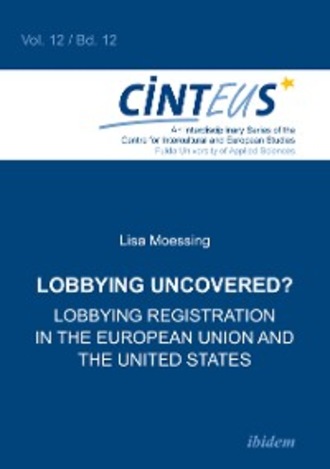
Полная версия
Lobbying Uncovered?
Table 1. Classification of tendency indicators
For measuring the questions-related aspects of research, the following tendency indicators[6] have been specified in table 1.:
Tendency indicator Intention of measurement · The current number of registrants compared with the starting amount Increase in registrants, acceptance among interest representatives for the particular tool · Results of the technical and content-related comparison between both registers Differences and similarities, accessibility, starting points for improvement, efficiency, effectiveness · Incentivizing of registration with the EU register Acceptances among EU registrants and nonregistrants, efficiency, effectiveness · The complexity of registration requirements of the EU register as identified by analysis of the qualitative expert and actors interviews Perception of complexity, everyday handling, effectiveness, starting points for improvement · The perception among lobbyists of current consequences for noncompliance with the TR’s regulations Effectiveness of consequences, starting points for improvement · The perception of the monitoring system of the EU’s register Effectiveness and efficiency of monitoring system, starting points for improvement · The overall attitude among interest representatives concerning the voluntary configuration of the EU register Effectiveness of the voluntary configuration, classifying arguments for and against a mandatory registerBy combining various methods and indicators, the book at hand is designed to direct a scope of questions to the object of research, which should be as broad as possible. An additional value of this study is established by involving insider perspectives of European institutions’ personnel as well as interest representatives. Therefore, it is based to a major degree on interviews of qualitative experts, especially that of actors. The latter are perceived as the favored approach compared to quantitative interviews due to the following reasons: First, qualitative interviews allow for individual, subjective answers that are an essential tool, especially with regards to detailed personal experiences with the registration process, personal perceptions of the EU policy process, and constructive approaches for improvement. By that, this method afterwards allows explaining, understanding, and interpreting certain correlations simply; also classifications can be more easily generated. Second, such detailed information as gained through qualitative interviews cannot be provided by any scientific literature. As a third reason, qualitative semistructured interviews can be ‘tailored’ individually to the interviewee by a partly standardized interview manual and simply allow for further enquiries to clarify statements or additional questions that might arise. Nonetheless, the questions designed for the Brussels-based interest representatives are to a certain degree standardized for reasons of comparability, but have always been ‘tailored’ to the individual entity and person.
The interviews were all transcribed after they had been conducted. Further work included categorizing the answers that were referring to the same aspects and interpreting statements to develop theses. Particularly important here were the categorization and selection of answers referring to the discussion about the TR, its sanctions and potentials for improvement, as well as their summary for a discussion overview. Another important part of the interview analysis was to develop new questions for the interview manual in case they originate as a consequence of interviewees’ answers. Interviews have mainly been conducted in person; in case it is impossible, phone calls or e-mail enquiries have been used. All the interviews ranged 30-40 minutes in length. Research and interviews have been accomplished during the TR’s second year of operation, with the revision of the register starting in June 2013.
More precisely, the following representatives of the three EU key bodies as well as of the EU register’s key institution have been interviewed: A collaborator of the JTRS, referred to as ‘JTRS Staff’; a Member and Vice President of the European Parliament who will be referred to as ‘MEP’; a Member of the Cabinet of Commission Vice President Maroš Šefčovič, Commissioner for Inter-Institutional Relations and Administration, referred to as the ‘Commission Representative’; an Official working for the General Secretariat of the Council (GSC) of the EU, who will be entitled the ‘GSC Representative’; and another Official of the Council’s Secretariat, who, due to more broader responses, will be referred to as the ‘Council Official.’ Further input could be gained through an e-mail interview with one of the distinguished present-day scholars on EU lobbying, who will be mentioned as ‘EU Lobbying Expert.’
The interviewee selection covers both national and European associations, as well as four of the following categories of the EU register (emphasized in boldface): Professional consultancies/law firms/self-employed consultants; In-house lobbyists and trade/professional associations; Nongovernmental organizations (NGOs); Think tanks, research and academic institutions; Organizations representing churches and religious communities; and Organizations representing local, regional, and municipal authorities, other public or mixed entities.
Respondents on the part of interest representatives are the following:
· An employee of the Brussels office of the PR and communications firm Burson-Marsteller (BM), representing professional consultancies, and referred to as ‘the BM Consultant.’
· The Head of Brussels office of one of the 10 biggest European companies who accordingly will be cited as the ‘In-House Lobbyist.’
· A member of the Brussels European Policy Office of the World Wide Fund for Nature (WWF), representing NGOs and entitled ‘the WWF Employee.’
· An associate of the Brussels office of the German Aerospace Center (Deutsches Zentrum für Luft- und Raumfahrt, DLR) as a think tank representative, named ‘the DLR Employee.’
· A member of the Brussels representation of The German Business Representation (Bundesverband der Deutschen Industrie e.V., BDI), covering national associations, being referred to as ‘the BDI Employee.’
· An associate of BUSINESSEUROPE, the “main horizontal business organisation at EU level”[7] and thus a European association, named ‘the BUSINESSEUROPE Employee.’
· A representative of euRobotics, a newly established European association, entitled as ‘the euRobotics Employee.’



